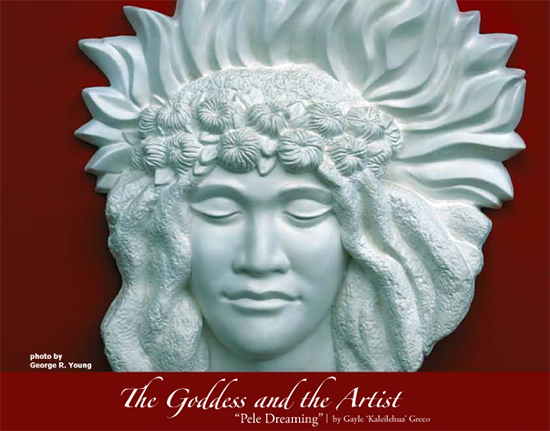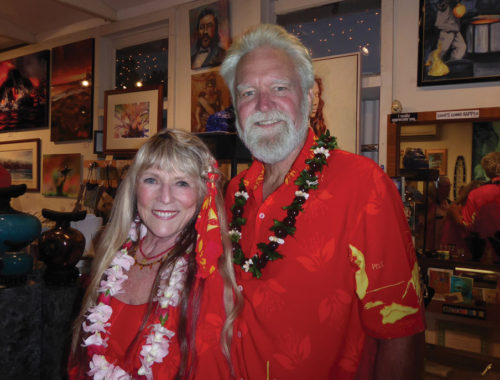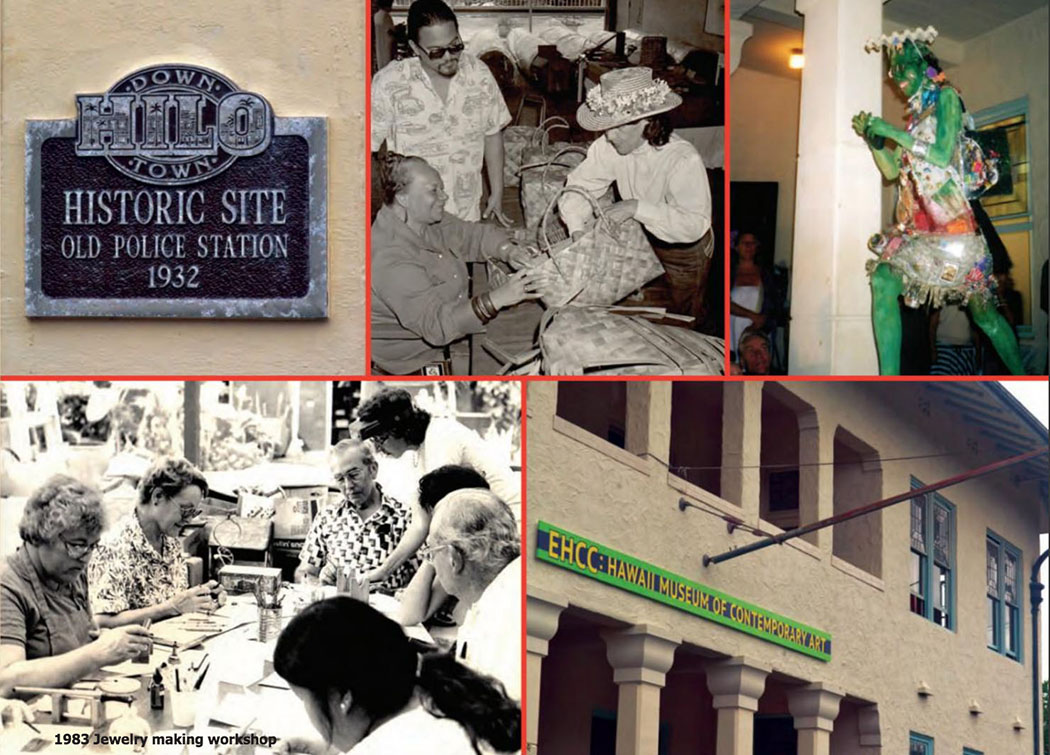
Through the Years: Hawai‘i Museum of Contemporary Art
 By Le‘a Gleason
By Le‘a Gleason
Lourdan Kimbrell is running late. It’s because he’s at the airport picking up photographs for an upcoming show of Kohala’s archeologically significant areas. Inside the Hawai‘i Museum of Contemporary Art (HMOCA), it’s not just the Director, Lourdan, who has a full plate.
Artist and long-time Hawai‘i resident, Ken Charon, is busy installing the Trash Art Show, a recycled art show started by Ira Ono 26 years ago. Upstairs hangs a painting of Leila Mehle, known as the “patron saint of Big Island Art,” painted by Ken.
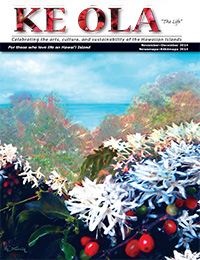
Across the hall from the painting is a large, colorful abstract painting by Steve Irvine, another long-time artist and advocate for arts in East Hawai‘i. Back downstairs, several people sit at computers in a small office working busily. Here at HMOCA, volunteers work in shifts and share desks to plan art classes and exhibits and work to develop a new image for the longstanding downtown venue.
None of the HMOCA volunteers are paid, including Lourdan, who has been instrumental in the facelift. Instead, it’s a love for the arts and a drive to see a community venue continue to thrive that keeps them going.
Forty-seven years ago, the building, which stands at the corner of Kalākaua Street in historic downtown Hilo, was a police station. It later became the East Hawai‘i Cultural Center, a venue which was governed by the East Hawai‘i Cultural Council, an arts advocate group.
Throughout the years, many art shows, performances, children’s theater workshops, classes, and other gatherings have filled the walls of the former police station with happiness and laughter.
Management and the people who govern this place have changed over the years, and with the ebb and flow of different energy, so too have the programs shifted.
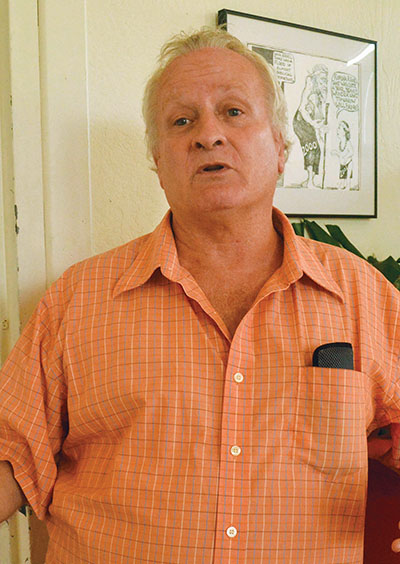
Two years ago, Lourdan joined the ranks. He hails from California, where he administrated art-related nonprofits and worked as a professor at California College of the Arts. After being invited to serve on the Council, Lourdan says he looked around the facility and saw major potential.
His mission was the major motivation for shifting the name to the Hawai‘i Museum of Contemporary Art.
“Our purpose is to educate …we believe that culture itself depends on new energy and new ideas to ferment further development of culture. The culture then retains what is beneficial to the community and disposes of what’s not. Our value here is to expose these communities to a greater global presence. It’s no longer just saying we’re Hawaiians, but we’re human beings and we’re part of this whole experience. If you aren’t able to go elsewhere, it would be nice to have a place to come that brings those things to you. It’s also educational and you grow up valuing art,” he says.
As he walks around the facility, he points out features full of endless possibilities.
“This is going to be a museum shop, and that’s going to be a café out there,” he says, walking through a smaller room adjacent to the main gallery. “And we are in the process of replacing and restoring all the windows in this building.”
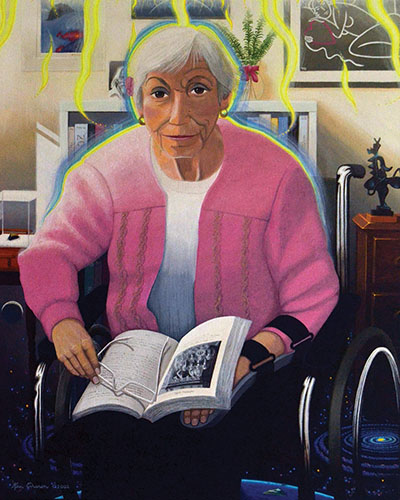
Upstairs, Lourdan envisions a certified kitchen where visiting chefs can cook and everyone can sit at a large table enjoying communal meals.
He heads out back to show a new multipurpose space being renovated. Here, one can see several of the doors and windows that still have bars on them, as they were originally the women’s holding cells.
“This 800-square-foot room was a junk heap that’s all been cleaned out. The brand new level floor can be used for textile designs and all kind of outside things. We are revitalizing the facilities,” he says.
There’s also the former annex, which is becoming a gallery space with restored period-appropriate doors, a large workspace for printmaking, and a resident artists quarters.
“Not only do we want to support the local community, but the artist community at large. Who doesn’t want to come to Hawai‘i and paint? Let’s bring the international community here and have them stay,” he says.
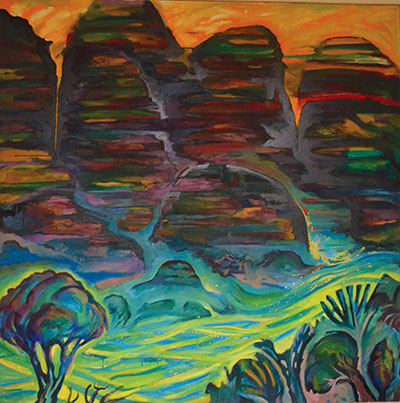 Lourdan smiles as he talks about everything that’s to come. It’s September now, and by the time this story publishes in November, many of these renovations will be complete and HMOCA will already begin to offer some innovative new programs to the community.
Lourdan smiles as he talks about everything that’s to come. It’s September now, and by the time this story publishes in November, many of these renovations will be complete and HMOCA will already begin to offer some innovative new programs to the community.
“We’re trying to figure out what we want to teach here. We’re more interested in teaching high-end things like metal casting, fabrication, jewelry design, fashion design. Let’s find out what the community will support. I’m focusing more on what we don’t [already] have [in Hilo]. What about gem setting classes and hand beading jewelry?” Lourdan says.
Inside, the Trash Art Show looks superb. In particular, two large Samurai made from car tires and other medium painted jet-black have captured jurors’ attention and have a little pink post-it indicating an award.
Other standouts are a pair of swim-trunks quite literally made out of a trunk of an Albezia tree inspired from the wreckage of Tropical Storm Iselle.
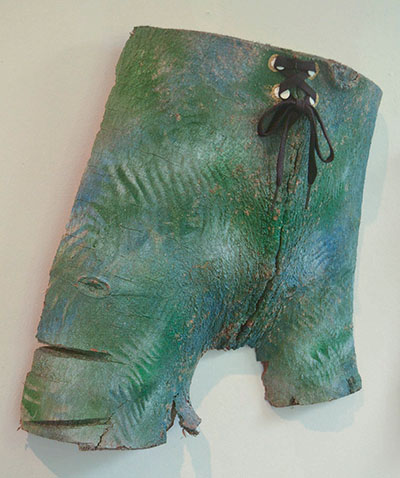
That evening, the Trash Art Show opening goes off without a hitch to the welcome of a giant crowd.
Ira Ono remembers how the show first started.
“I’ve been doing recycled art for many, many years. Starving artists do this because we can’t afford materials. I’ve taught for many years in places that had no budget so I’d dumpster dive in the garment district for supplies for my students in Harlem and find things and use them and make things out of them. I noticed the things that were made using reused materials were very beautiful and provocative and that’s interesting to me,” he says.
As a member of the Cultural Council, Ira says he thought the show “was relevant at the time.” Recycling and wearable art had been recently coined, and it was a natural progression, he says.
“Such beautiful provocative items were being made by myself and many people so I said, ‘let’s have a show; not just any show, but a juried show,’ and the concept was to make a political statement, be technically very well crafted, and I liked large statement pieces—big pieces, so that was the criteria. It was a wonderful show and it got quite clear: let’s just keep going with this,” Ira says.
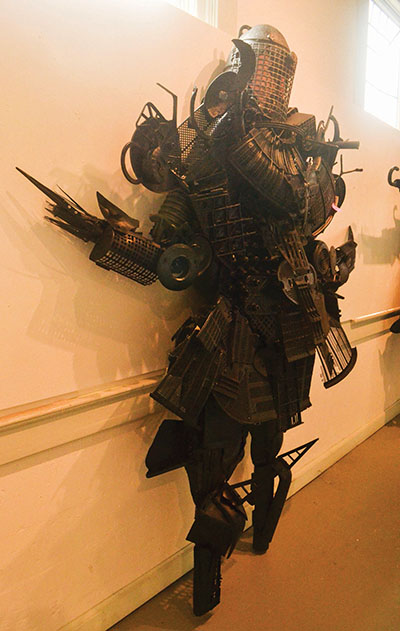
The show went on to have an impressive run on O‘ahu before it lost funding and was permanently established on Maui with a trash fashion show component, as well.
For Hilo and the HMOCA today, it’s an annual show that brings an exciting challenge to arts and recreational crafters.
“Often established artists will stop what they’re doing and create just for the show, and then there are people who wait all year and think up a theme and collect objects. We’re talking about mixed media here so it takes people out of the box. You’re thinking in a three-dimensional form. One year, somebody made an amazing piece out of corks of wine bottles. It definitely becomes a challenge using materials that are not traditional and trying to use them in a traditional way,” he says.
Ira says the show has a tremendous following and he calls it the beginning of the social season in Hilo. The large crowds at show openings and people’s rave reviews have evidenced the success of the event over the past 26 years.
HMOCA is also home to three other recurring annual shows: Young at Art, Fall Arts, and Summer Arts. They also just inherited the Big Island Photo Expo this year.
During the rest of the year, the facility is home to installations and was recently offered one extra special exhibit.
“Since we’ve become a museum, I got a wonderful letter from Mexico saying, ‘we would like to send you all the clothing and costumes of Frida Kahlo.’ We couldn’t afford the insurance costs, but it was an indicator to me that we were moving in the right direction,” Lourdan says.
Other standout performances for Lourdan have been Egyptian belly dance, Siberian Troups, poetry slams, film nights, and a program called House of Magic where magicians come and teach kids magic tricks. There’s also the Little Miss Radish Program for kids where they make puppets, write a script, perform, film it, and air the show on PBS.
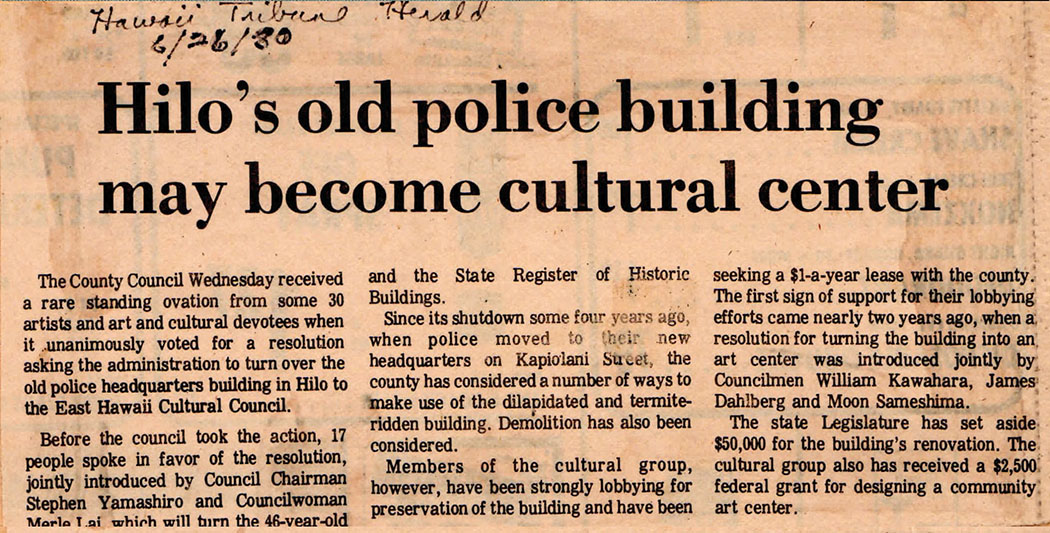
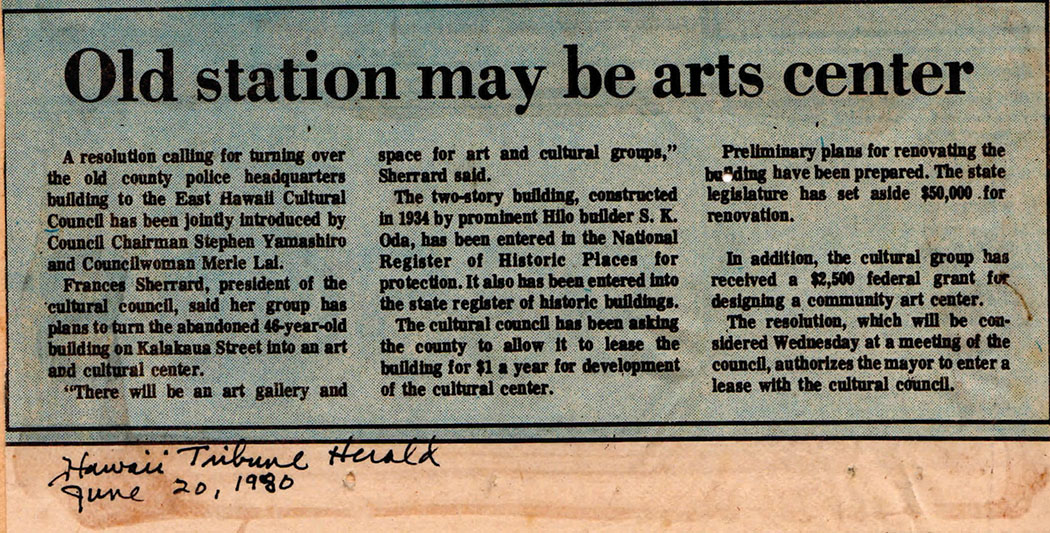 Even though Lourdan might only have two years under his belt here, the walls remember each child who danced onstage, each artist who ever swiped a paintbrush, and each pair of loving hands that have worked on renovations and maintenance of the facility over the years.
Even though Lourdan might only have two years under his belt here, the walls remember each child who danced onstage, each artist who ever swiped a paintbrush, and each pair of loving hands that have worked on renovations and maintenance of the facility over the years.
“It’s a perpetual theater. You don’t rest ‘cause the next one is coming around the bend. You have to like chaos and be able to maintain equilibrium,” Lourdan says.
Back upstairs, Lourdan unlocks the door to a dressing room that doubles as an archive. Boxes and stacks of albums fill the shelf. Inside, there are hundreds of photos, pictures and programs from events throughout the history of EHCC and HMOCA.
Looking through the photos, what’s most clear is how many hands have gone into supporting the arts here over the years. Photos show crowds smiling at art openings, women gathering around tables outside to sew lei or dance hula, teachers addressing fascinated students during workshops, and more.
Early headlines read, “Police station to become art center,” while numerous later headlines read things like “Event Slated at EHCC.”
About this community of hands, past and present, “I could not do all the things I do without the team of people who make it happen. It’s about community. The volunteers who come in are all important,” Lourdan says.
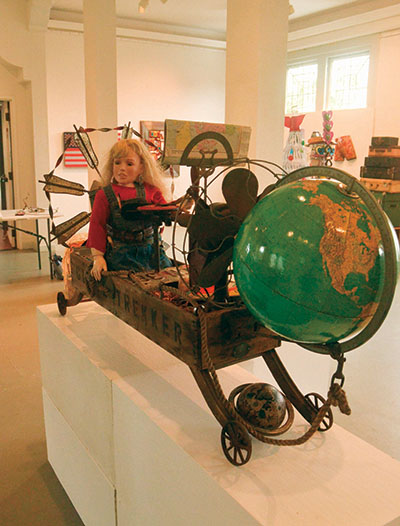
When asked why this project matters so much, especially to a group of volunteers like him who have to drive to the airport to pick up photos, arrive late to meetings, and stay afterwards to clean up after everyone else has gone home, he simply says, “It matters in many, many ways.”
“Without educating future generations about the value of art, there won’t be any art, and art is a component to being human that has always been. Without it, you are actually taking part of what it is to be human away from people. Our particular society in America tends to marginalize art as the weird or the strange. But if you say art is merely expressing something that can’t be expressed in any way to the person creating it, then it’s like a sonata or any other form of creation,” he says.
Lourdan might have been late from the airport, but it’s no consequence. He’s just on time for the Hawai‘i Museum of Contemporary Art. His passion for living and breathing art is evident in the ways he talks about it.
“As an educator people would come to me and say ‘I can’t draw’. It’s not unusual; we can all draw—it’s an innate human trait. In my case I grew up in a family that didn’t value art and it was dismissed. I grew up thinking I’d never teach that way. A place like this is very important because we need to express ourselves. Who are we as human beings? What is it that we’re giving to the world? What is our place? How can we change? All these answers to these philosophical questions need to be addressed everywhere on the globe, because places like this, they inspire,” he says. ❖
Photos by Le‘a Gleason
Contact Hawai‘i Museum of Contemporary Art: ehcc.org
Contact writer Le‘a Gleason: lgfreelancehawaii@gmail.com
